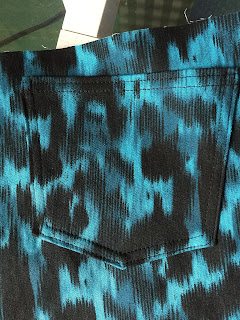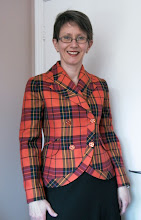Because I'm really not completely comfortable in jeans that hit me a good 3" below my actual waist, especially when they are tight enough that the back pulls down further when I'm doing anything other than standing up straight. Which is 90% of the time I figure.
Maybe if I was 20 years younger.

On the other hand, with the top of them and my belly button and all decently covered, they look not bad, if I do say so myself. In particular, this camera angle makes me look like I'm all legs, which is assuredly not the case. So let's just go with it.
And it was a really fast pattern to make up, even though I was fitting on the fly.
Here's the always-popular rear end view.
And because this extremely busy print simply swallows up the details, here is a closer view of the front.
 |
| Front - extreme close up |
 |
| Back |
Really, the only way to see the details is to look at these inside out.
 |
| That square of interfacing? Fixing an "oopsie" from my serger |
 |
| Topstitch expert - me? |
I traced size T based on my hip measurement, but I added 1cm of insurance at the side seams on front and back (total of 4cm) because I wasn't sure of the tight fit. A try on while sewing indicated that I didn't need all of that. The final seams are 1.5cm so I have an extra 1cm on each side. They are plenty snug enough for my taste.
The only serious problem was at the waistline. My waist is size R (a 2cm difference between the sizes). I figured that because the pants are low rise, the waist measurement wouldn't matter that much. As with the Jalie stretch jeans pattern, however, the waistband was going to gap on me - badly - if I made it up according to the instructions. In part this is because of the size differential, but it's also the draft which is really straight at the back. I don't have a gigantic behind or a really pronounced sway back either.
The instructions say to attach the waist band elastic 1:1, that is do not stretch to ease in the fabric at the waist line. Dawn found that for her, pulling the back waist elastic out a tiny bit on either side was enough (total of 1/2" or 1.25cm). I used wider elastic (Jalie says 2.5cm or 1" elastic, mine is 3.75cm or 1.5") and I had to pull it in both in front (total of about 2.5cm) and in back (total of about 4cm). Between the stretch of the fabric and the elastic there is no problem at all getting them on and the waistband looks smooth enough when I'm wearing them.
Next time I make these I think I will add more to the rise - not a lot, maybe 1cm all round, plus cut a small wedge in back to give myself more sitting room and enough back height so I'm not at risk of exposing my unfashionable undies when I sit or bend over.




































